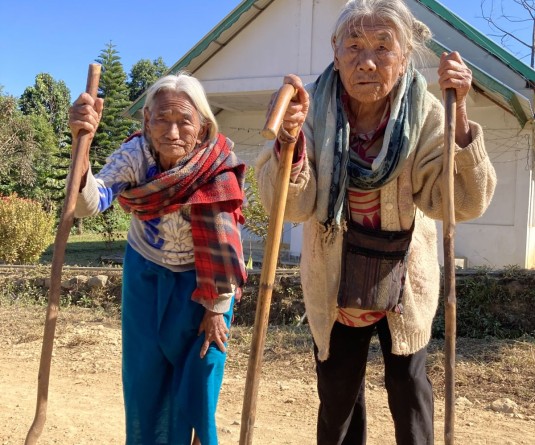
(Part-I)
Satyaraj Hazarika, IPS
Deputy Inspector General of Police Assam
Introduction:
The Christian Kachins reside in the north of Myanmar sharing borders with India at the tri-junction at Walong, where China's border also meets. For fifty years the Kachin guerrillas are fighting against the Myanmar army in a war of attrition, with no peace in sight. In the geopolitical chessboard of South East Asia, Kachins a landlocked state is sandwiched between two Asian heavyweight nations, India and China, often with shifting alliances. Myitkyina straddles the Ledo road that connects the Indian town of Ledo, in Assam with Kunming the capital of Yunnan province of China.
The formation of KIO (Kachin Independence Organization) in 1960 is the brainchild of Zau Seng and Lamung Tu Jai. But the credit for creating the political movement and eventually the Kachin insurgency goes to Kachin war hero Naw Seng, who was in China from 1951. Zau Seng took guidance from Naw Seng in exile.
For his services in routing the Japanese by British Gen Slim’s Fourteenth Army the Northern Kachin Levies (NKL) of whose officer Naw Seng was awarded the Burma Gallantry medal twice. Out of the soldiers of NKL the British formed the 1st Kachin Rifles after the war in January 1945.
It was a difficult time for the nascent Burmese state after the British left the country in January 4, 1948, with the formation of Karen National Union on April of the previous year and the KNDO (Karen National Defence Organization). The assassination of Aung San who negotiated the transfer of power from Britain to independent Burma on July 19, 1947 even before independence, is bad news for the hill tribes of Burma. U Nu succeeded Aung San as the first PM of Burma. The Karen commander of Burma Army Gen Smith Dun was replaced by Ne Win as Commander in Chief. The removal of the Karen Army Chief and the subsequent riots the predominantly Karen dominated 1st, 2nd, and 3rd Battalions became restive as Burmans began to attack Karen settlements in the delta region of Burma. Two of the battalions revolted, but Ne Win and his loyal 4th Burma Rifles put the revolt down in the suburbs of Rangoon. The revolt also made the other hill tribes uneasy.
On February 16, 1949 Captain Naw Seng of 1st Kachin Rifles took his entire battalion and joined forces with the 1st Karen Rifles. But the combined Karen and Kachin forces were defeated near Meiktila by April 1949. By 1960 as Burmese government under U Nu could stabilize the country, Naw Seng withdrew to the hills north of Hsenwi, in northern Shan state.
Kachin Independence Army (KIA):
Founded on February 5, 1961 the KIA was the handiwork of three brothers -Zau Seng, Zau Tu and Zau Dan. The Kachins consist of six groups: Jinghpaw, Lachid, Lhaovo, Lisu, Rawang and Zaiwa. The Jinghpaw dominates the social and cultural life, and the nationalist elements of the Kachin society. The NDA-K was formed in 1989 and it became a BGF (Border Guarding Force) under Zankhung Ting Ying, who engineered the first split of KIO in 1968 to join the BCP (Burma Communist Party). The NDA-K was finally dissolved in 2009, which during its BGF role profited from the cross-border timber trade at Kambaiti and Pangwa, the groups base area. But the fissure within KIA developed as the second group emerged based in Shan State, the 4th Brigade led by Mahtu Naw in 1990. The ousting of KIA camps near Indian border by Tatmadaw (Myanmar Army) in 1992, leading Brang Seng to sue for peace in 1994. The first ceasefire is inked. Tatmadaw formed a militia from the 4th Brigade of KIA that is located in the Shan state and it is better known as Kaungkha militia. With the Rawangs, who are residents of Putao and Nawngmun towards the Arunachal Pradesh border, the Tatmadaw in 2011 formed an EAO (Ethnic Armed Group) known as Rebellion Resistance Force (now known as People's Militia Force). The group is based in Khaunglanphu, and used as a counter-weight to the KIA in Kachin state. Similar groups of Lisu's sprang up in Myitkyina that are supporting the Tatmadaw's offensive against the KIA in 2016 and clearly shows which side the wind is blowing in Kachin state. KIA gave access to Naga and Mizo rebels through its territory in the 1960s.The Naga and Mizo militancy peaked due to the foreign returned insurgents, and ideologically motivated.
But the KIO came closer to New Delhi from 1988 and the ULFA (United Liberation Front of Assam) and NSCN-IM (National Socialist Council of Nagaland-Isaac Muivah) was denied sanctuary soon after that rapprochement, that resulted in Indian Army launch Ops Bajrang in Assam in November 1990, subsequently Ops Rhino in September 1991 dismantled the ULFA from their bases close to Myanmar border, in Arunachal Pradesh.
KIA is with the Northern Alliance of UWSA (United Wa State Army), MNDAA (Myanmar National Democratic Alliance Army), TNLA (Ta-ang National Liberation Army), NDAA (National Democratic Alliance Army) and Arakan Army. Out of this alliance all the EAO are from Shan State, but Arakan Army is from Rakhine State, in the South of Myanmar, near India's Mizoram.
All the Shan State EAOs are heavily invested in the drug trade with UWSA is the most important with a large standing army. The KIO had banned opium poppy cultivation in Kachin State in 1984. Increasing political pressure on KIO to accept the BGF proposal was the reason of the breakdown of the 17 years old ceasefire. As KIA came under pressure it supported the formation of new armed groups-the TNLA (Ta-ang National Liberation Army) and Arakan Army equipping and training them in Laiza since 2009. These groups increased conflict in northern Shan State, aligning with like-minded armed groups. Similar pressure tactics was put on MNDAA in Laukkaing, the capital of Kokang, famous for its notorious casinos on the Chinese border, with an attack on August 2009. The MNDAA chief Peng Jia Sheng fled to China.




